Transportation, along with manufacturing and warehousing, is one of the main supply chain processes. It comprises many activities—from delivery planning to carrier management to shipment tracking—that must be properly handled. Small businesses with few shipments can manage these operations with the help of spreadsheets and phone calls. However, once your turnover rate grows, it becomes obvious that Excel is not enough and you need something more robust to control your transportation processes. That’s where specialized technology comes into play.
What is a Transportation Management System (TMS)?
A transportation management system or TMS is a category of software that helps in planning and executing the physical movement of goods. It can be used by all members of the supply chain from manufacturers to distributors and third-party logistics providers (3PLs) - virtually any party that wants to coordinate shipments.
The sought-after feature of TMS is its control tower capabilities, illustrated below.
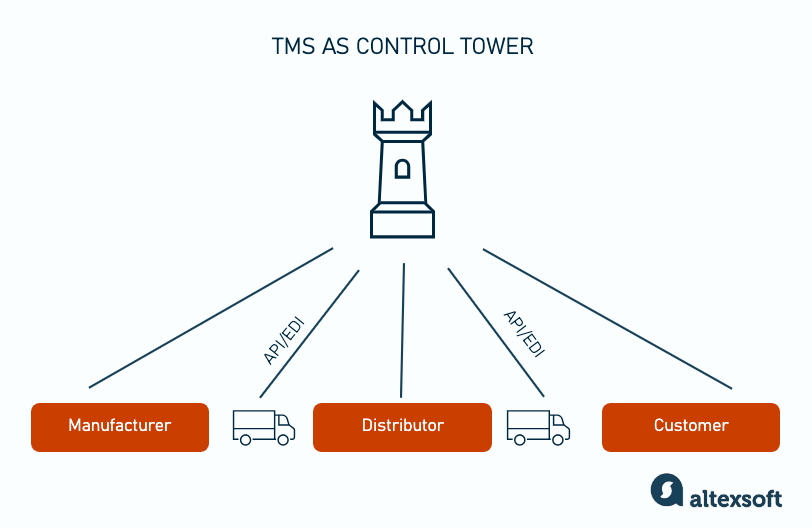
TMS receives data about the status of transported goods via API or EDI channels
Overlooking the whole shipment process, a TMS control tower captures data about goods in real-time via API or EDI connections and thus provides all users with valuable updates as shipments move from manufacturers to distribution centers, through delivery, and to customers. You can read more about API and EDI in our detailed overviews.
This data can in turn be transformed into analytics on your supply chain performance, financial situation, and customer service issues. Which is where you start your optimization journey.
Essentially, a TMS allows you to plan and execute your shipment processes and have visibility over them. Such software is often modular, meaning that you can get different functions separately depending on your needs. Besides, your ecosystem of tools may consist of different modules of ERP, logistics management systems (LMSs), warehouse management systems (WMSs), and of course, TMS. Some features will interconnect with fleet management software as well.
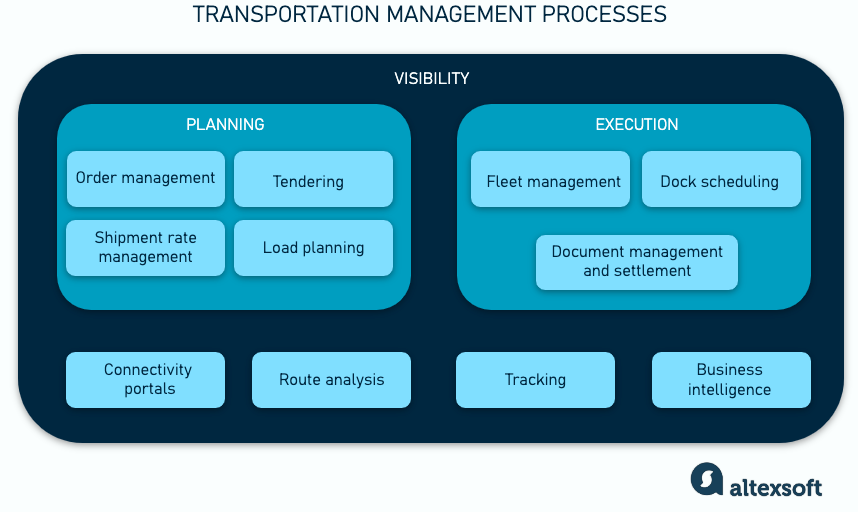
Main TMS functions and corresponding processes within them
Vendors usually offer a wide collection of possible integrations to make sure you can freely connect to your WMS or ERP. We will talk about those capabilities later. Now, what companies can benefit from a TMS?
Who uses transportation software?
Transportation management systems serve various businesses and industries that need to plan, execute, and optimize the movement of goods. Some key users include the following.
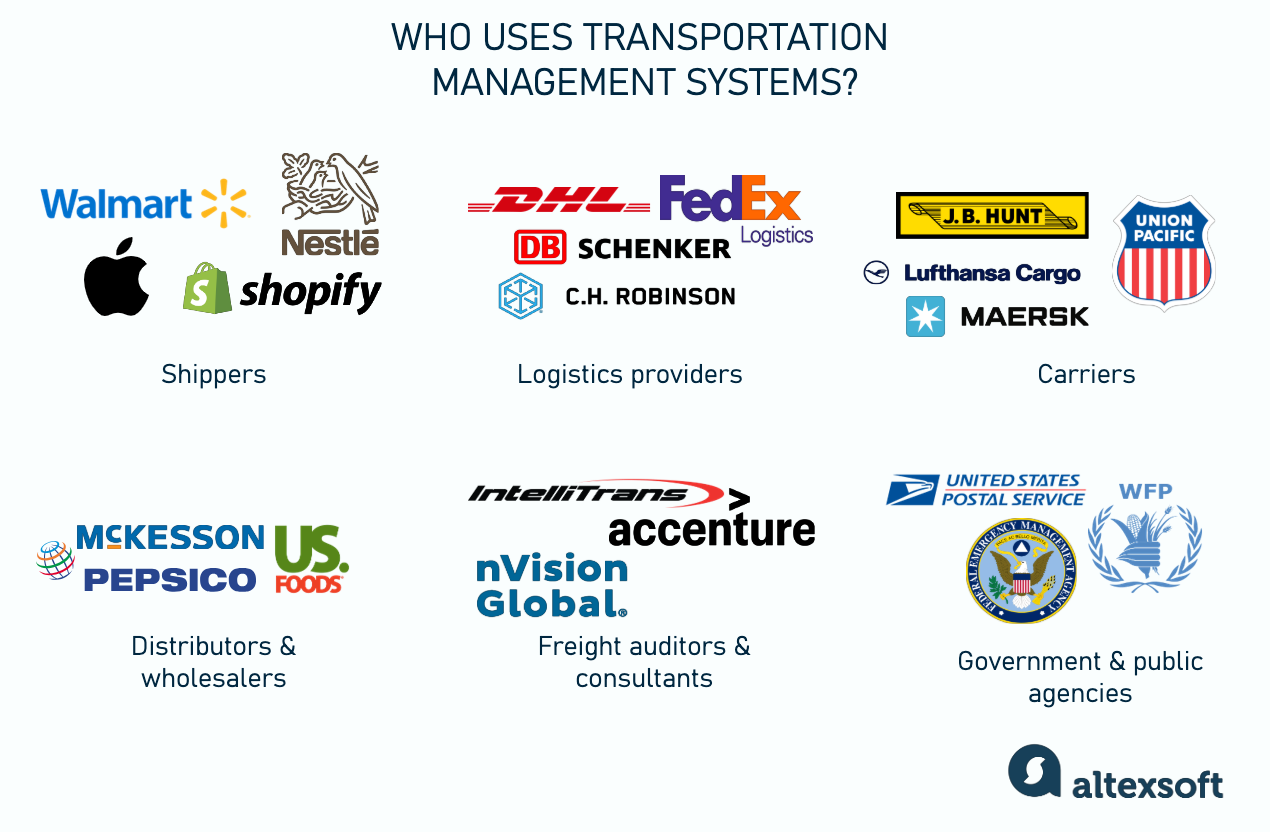
Overview of TMS users
Shippers. Companies that move products rely on TMS to optimize costs, track shipments, and ensure timely deliveries. This includes retailers, manufacturers, and eCommerce businesses that need to track shipments, automate freight payments, and optimize route planning.
Logistics providers. Companies managing transportation for others employ a TMS to manage multiple clients’ shipments efficiently. Third- and fourth-party logistics companies, freight forwarders, and brokers need to optimize fleet and carrier selection, handle documentation, automate rate negotiation and more.
Carriers, such as trucking companies, rail operators, air cargo companies, and ocean shipping companies use a TMS to optimize fleet operations, track vehicles, and improve fuel efficiency.
Distributors and wholesalers that manage large inventories improve order fulfillment and reduce transportation costs with the help of a TMS. They benefit a lot from optimizing multi-stop truck routes, shipment tracking, ensuring compliance, and schedule automation.
Freight auditors and consultants use TMSs to audit transportation costs, optimize logistics networks, and improve efficiency. TMS data helps redesign networks and identify cost-saving opportunities.
Governments and public agencies utilize TMSs to manage transportation infrastructure, emergency response, and military logistics. Here, postal services ensure optimized mail deliveries, military logistics companies enhance supply chain resilience, and emergency and disaster response agencies coordinate relief supply deliveries.
Transportation planning features
The transportation process starts with creating a transport request containing quotes and details about the shipment. Shippers tender loads to carriers who, in turn, have to plan the capacity and cargo distribution.
Order management
In a TMS, order information is accessed by all related parties from planners to drivers and customers. Here are the features that help users manage transport requests.
Order entry. Manual or automatic, order entering includes filling in all essential details like commodity or weight and setting up the current location and destination. A system often generates a route, assigns transport and driver, and calculates ETA. If you have an integrated WMS, this order automatically goes to its scheduled transport.
Order overview. Created orders with their routes and assigned transports are available to order planners and drivers on a dashboard that allows them to see their workload for the day. All documents are linked to their corresponding orders so the driver can keep them on their smartphone or tablet. As drivers update the status of orders en route, planners have an overview of all scheduling changes and truck locations.
If you want to learn about order management in more detail, please refer to our dedicated post.
Tendering
Most TMSs tender shipments for you automatically. The list of carriers is organized so you can always access the vendor according to your specified parameters or allow the software to choose a carrier for you. Most systems support broadcast, waterfall, and status tendering methods. For example, IntelliTrans has the following tendering strategies:
- least-cost, when it chooses the lowest rate and expands this offer to other carriers,
- auto-award when shipments are always assigned to specific carriers;
- allocations when using contractual percentages or by the load numbers (4 numbers to Carrier A and 3 numbers to Carrier B);
- service-based when picking the best-performing carrier;
- customer-based when picking the carrier that a customer prefers, etc.
Now let’s move to the next planning feature in a TMS.
Shipment rate management
One of the most important tools within a TMS is a rate engine. It calculates transportation rates for the parcel, LTL, truckload, and intermodal shipping based on rules: base rates, discounts, and contract agreements. A TMS should be able to create custom pricing rules to accommodate the most complex tariffs and automatically send a quote to a client as they make the request.
Load planning
You can efficiently plan the loading space of trucks, trailers, and containers, considering your vehicle measurements and data about the item dimensions that come from the freight order. Some TMSs have the 3D load plan feature where you can see and change the cargo distribution and space utilization.
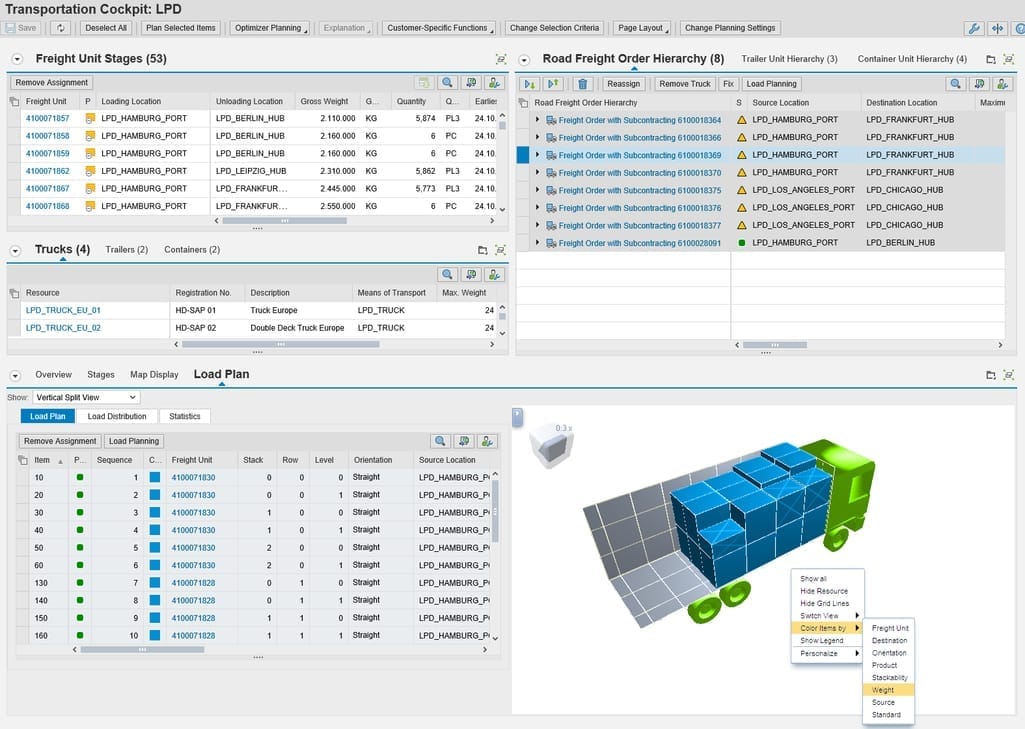
In SAP Load Planner, you can set up the load plan hierarchy and quickly relate to the items by color. Source: SAP
Transportation execution features
Now that the shipper and carrier got to the agreement, the load has to actually be transported. There’s not much a TMS can do to deliver freight, but it can help with fleet management, dock scheduling, and settlement processes to ease the burden.
Fleet management
If you operate your own fleet, a TMS will let you see and utilize your assets on a single platform. Although not all TMS providers have advanced fleet management features, you can assign drivers and equipment, plus manage dispatch and financial settlement for drivers.
If you’re using dedicated fleet management software, you can go as far as managing fuel consumption and environmental impact, keeping track of vehicle checkups and maintenance activities, and controlling the truck remotely.
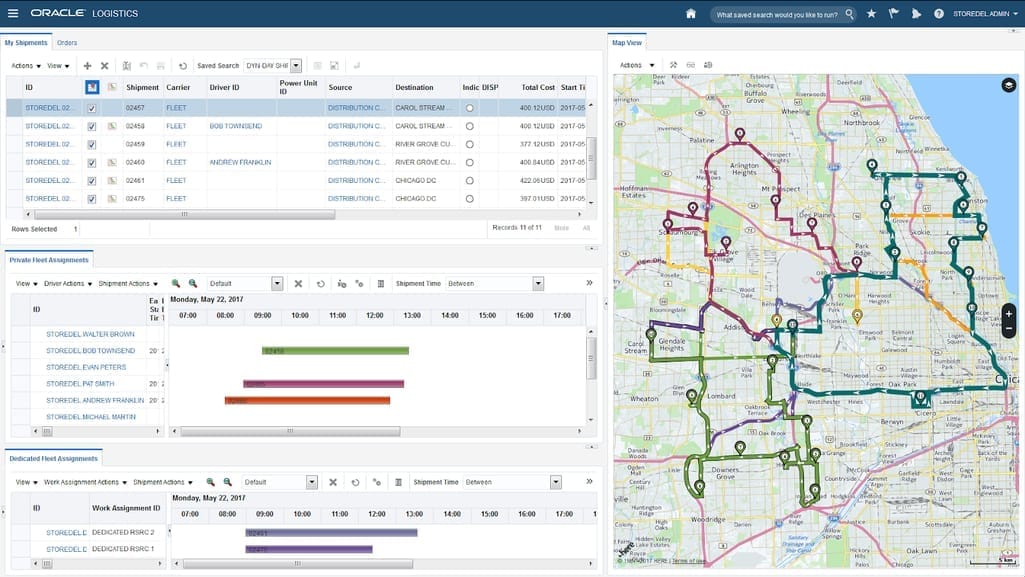
Oracle Fleet Management has end-to-end support for fleet and asset management with driver education, CRM, and dispute management capabilities. Source: Oracle
Dock scheduling and yard operations
Shippers spend most of their time scheduling dock appointments and truck drivers waste time waiting in line for their turn. Integrating with a WMS or a yard management system allows a TMS to include dock scheduling and load sequencing in the transportation plan. Here, you have an overview of all warehouse and transportation constraints and can optimize schedules (automatically or manually), apply your business rules and rules of every location, and always have a load status available to you or customers.

IntelliTrans TMS provides Dock Scheduling both as a part of their solution and as a stand-alone module
Documentation management and settlement
Transportation, especially the settlement part, is a complex and documentation-heavy process. However, there is certain progress towards automation. Today, TMSs can generate digital bills of lading, create invoices, and conduct freight auditing. You’ll be able to streamline your billing and invoicing activities, set up automatic payments, and enhance claims management.
Transportation visibility features
Okay, you’ve got your shipment delivered. But that’s still not the end. How would you connect to your partners to support your business relationships? Or are you going to analyze your operations to make effective decisions about future operations? A TMS can help you with that as well.
Connectivity portals
A TMS usually supports connecting to partners and customers via email, but some vendors provide customizable self-service portals. That’s where customers create and view the status of their orders, while partners submit tender offers as well as review and submit invoices.
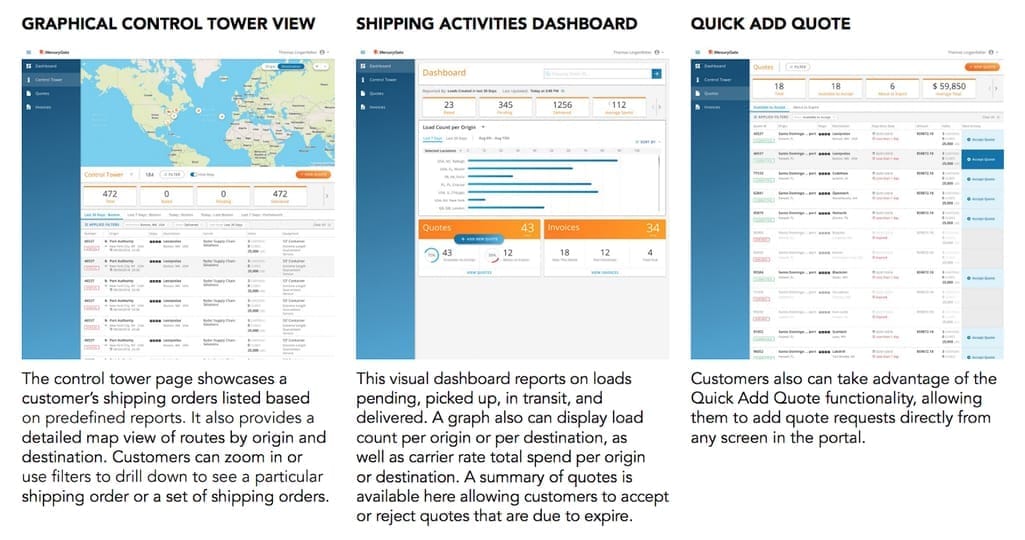
Customer portal by MercuryGate TMS gives access to order details and shipping KPIs. Source: MercuryGate
Route analysis
Although planning is the core function of a TMS, routing is not its strong suit. To optimize their routing activities, many businesses use specialized software that, unlike TMS, have all types of algorithms to calculate the best routes. So, if the routing capabilities of your TMS are not enough for your needs, you might have to use a combination of these tools.
Tracking, tracing, and event management with telematics and RFID
Track and trace technology allows you to record the movement of items during transportations in real time. Meaning that you don’t have to contact the driver to learn the truck’s location but can view it continuously.
This is often used to give customers information about their shipment location, as well as for security and scheduling purposes.
A telematics device in a truck or a driver’s smartphone is linked to the TMS via such telecommunication systems as GSM, GPRS, or UMTS. You can visit our article about telematics systems to know more about how it works.
Shipments can also be traced via barcode or RFID tag: Each time it’s scanned, for instance, at a distribution center, a TMS receives an update on its location.
Business intelligence and analytics
Business Intelligence is the practice of improving business results using data. The biggest advantages of BI over regular spreadsheets are real-time analytics and an array of custom reports that anyone from the transportation management team can generate for their needs.
For example, you can review a performance analysis based on each carrier, product, or route and then make informed decisions (e.g., optimize the route or break up with an underperforming carrier). Or, you can get the analysis of your costs filtered by transport mode, see which customers bring the largest volume, monitor the margin data -- and improve the operational workflow.
TMS integrations
As we mentioned, a TMS is usually a part of a company’s IT ecosystem. For smooth and efficient functioning, it has to be seamlessly connected to other systems (both internal and external) so that accurate data exchange is established. Let’s look at what other software you might need to integrate with – and why.
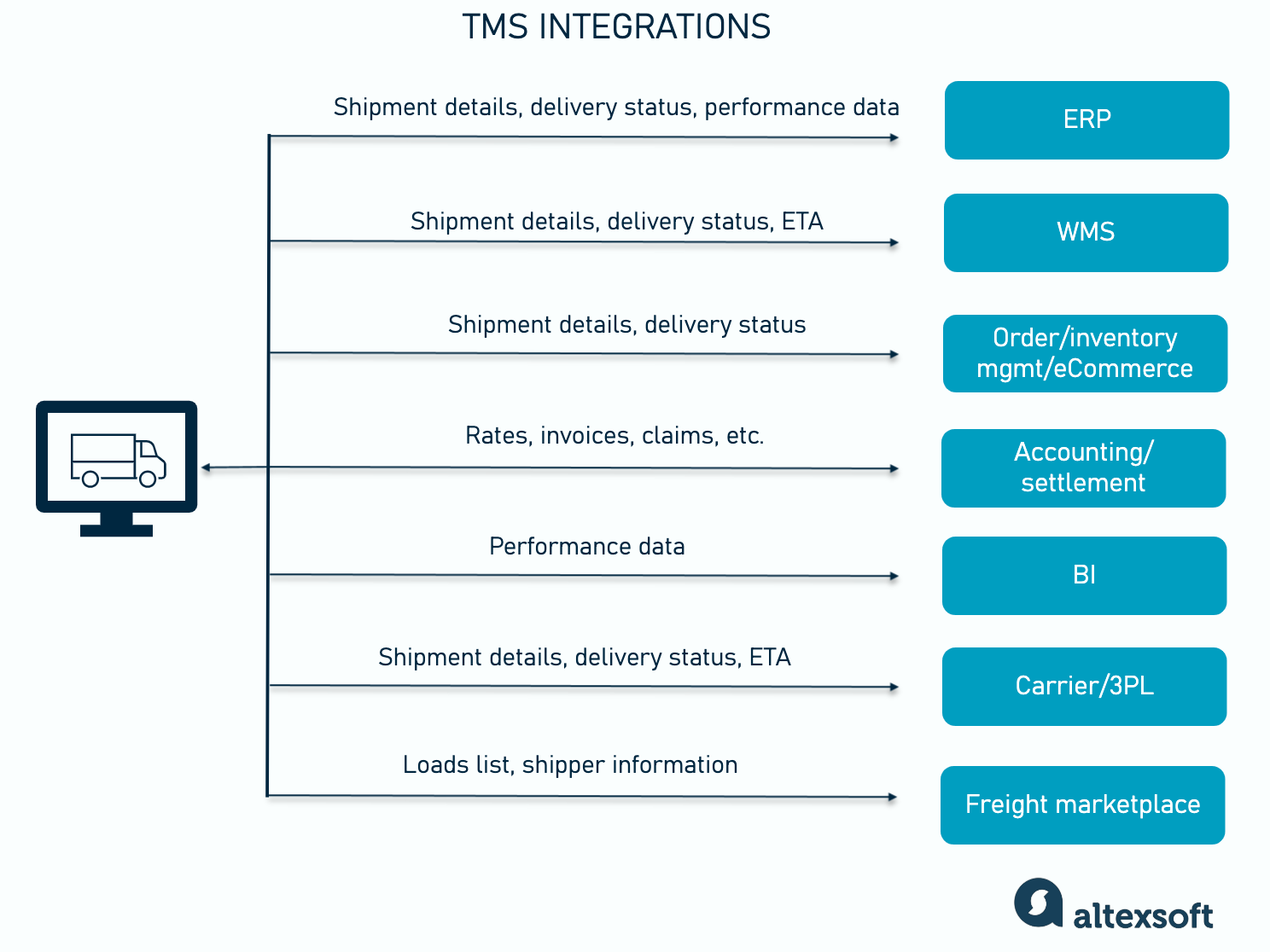
TMS integrations
ERP. An ERP is usually the core of a company’s IT infrastructure, controlling all business processes (manufacturing, transportation, sales, finance, marketing, etc.). If you have a separate ERP platform, integrating it with a TMS is crucial to exchange order details and accurately plan transportation activities.
Warehouse management system (WMS). If you utilize a specialized WMS, connecting it to a TMS will let you properly coordinate your warehousing and shipping operations. Once you set up the data exchange, you’ll be able to share shipment information and schedule loading/unloading.
Order management/inventory management/retail/eCommerce solution. If you’re a distributor, you most likely have focused software to connect the dots in your sourcing and sales operations. If you integrate it with a TMS, it will be easier to manage your shipments.
Accounting/settlement tool. Even though you can run your settlement processes within a TMS, its functionality might not be enough for your specific needs. So, if you have a standalone accounting solution, connect it to a TMS to ensure accurate billing, invoicing, claims management, and so on.
Business intelligence. A specialized BI tool would most likely be more powerful and have stronger analytical capabilities than a BI module in a TMS. Integrating your TMS with a separate BI platform will let transportation-related data flow smoothly so that you can get a holistic analysis of your performance.
External carrier or 3PL system. Shippers can communicate with their partners (carriers, 3PLs, or freight forwarders) using a self-service portal or building an integration (it might also be a TMS, often a custom-made one) to easily exchange transportation data.
Such integrations enable carriers to receive load details (commodity type, dimensions, pickup and delivery locations, rate, etc.) while shippers can track goods (see the route, current location, who’s delivering, ETA, and so on.). Besides, it’s possible to share the related shipping documentation.
Freight marketplaces. If you are a 3PL or owner-operator, you might be using load boards and freight marketplaces to keep your trucks busy. Integrating your TMS with such platforms will allow you to use their capabilities – all within your interface.
Transportation management software: overview of the main TMS vendors
For our comparison today, we will use some leaders and challengers (those dominating a large segment, but not demonstrating innovative ideas for the future) included in 2024’s Gartner Magic Quadrant.
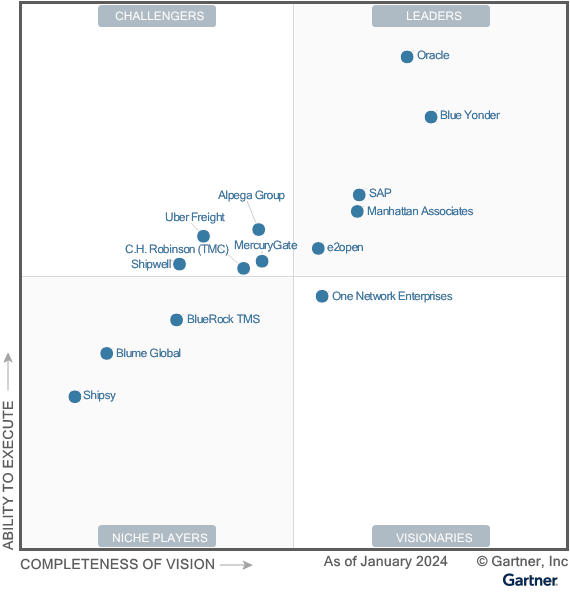
Gartner’s Magic Quadrant of TMSs for 2024. Source: Gartner
Before we go into specifics, here’s what you can expect from most major TMSs:
- all transport modes coverage: land, air, sea, sometimes rail, and multimodal (when all the options are regulated by a single contract and you can choose between them);
- capabilities for different use cases from shippers to 3PLs;
- cloud deployment; and
- a mobile app.
Now, what are the leaders and what do they offer?
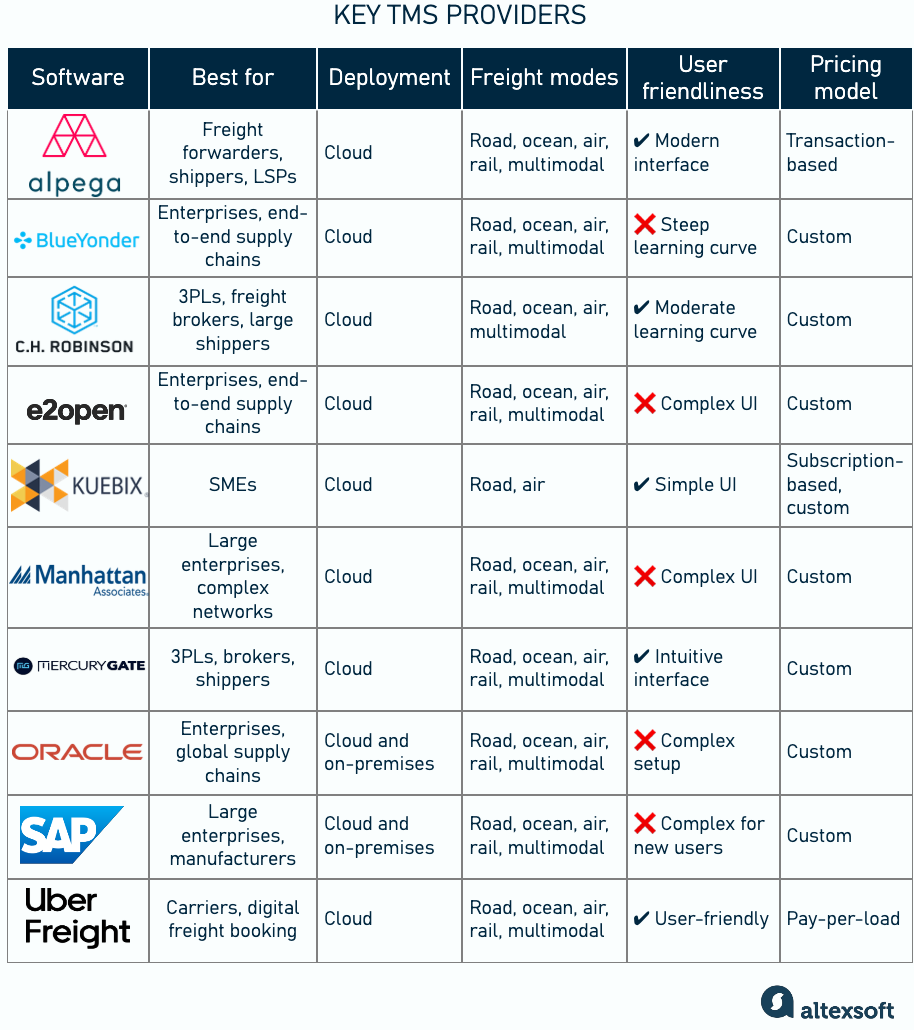
Comparing key transportation management providers
Alpega Group – flexible, modular TMS for European logistics
Alpega Group specializes in transportation management solutions tailored for European and global supply chains. Their cloud-based TMS is scalable for businesses of all sizes, offering:
- modular design, allowing companies to customize features for their needs;
- end-to-end freight management, covering contract and spot market transportation;
- integrated carrier network with direct access to European transport providers;
- automated freight procurement through a digital marketplace;
- sustainability tools for carbon footprint tracking and greener logistics; and
- real-time tracking with predictive ETAs and disruption alerts.
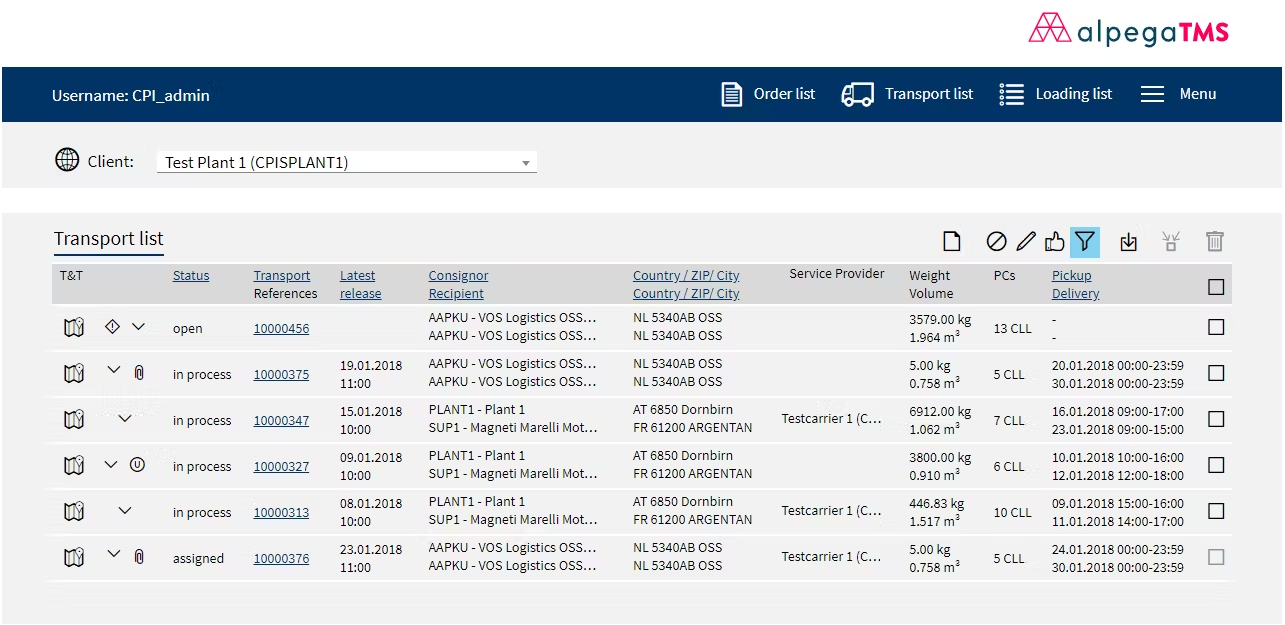
Transport list interface within Alpega TMS. Source: Capterra
Alpega TMS caters to different logistics needs, from SME-focused tools to enterprise-grade supply chain execution. Its European focus and deep carrier integrations make it a strong choice for companies operating in the EU.
Blue Yonder TMS – AI-driven optimization and real-time decision-making
Blue Yonder (formerly JDA Software) is a leading AI-powered supply chain platform. Its TMS is designed for large enterprises that need advanced planning and execution capabilities. It offers:
- AI-driven dynamic route planning and optimization;
- machine learning-based freight forecasting and demand sensing;
- integrated control tower for real-time shipment visibility;
- multi-modal transportation execution with automated carrier booking;
- digital twin simulations for testing logistics scenarios; and
- sustainability tracking to monitor carbon emissions and optimize eco-friendly routes
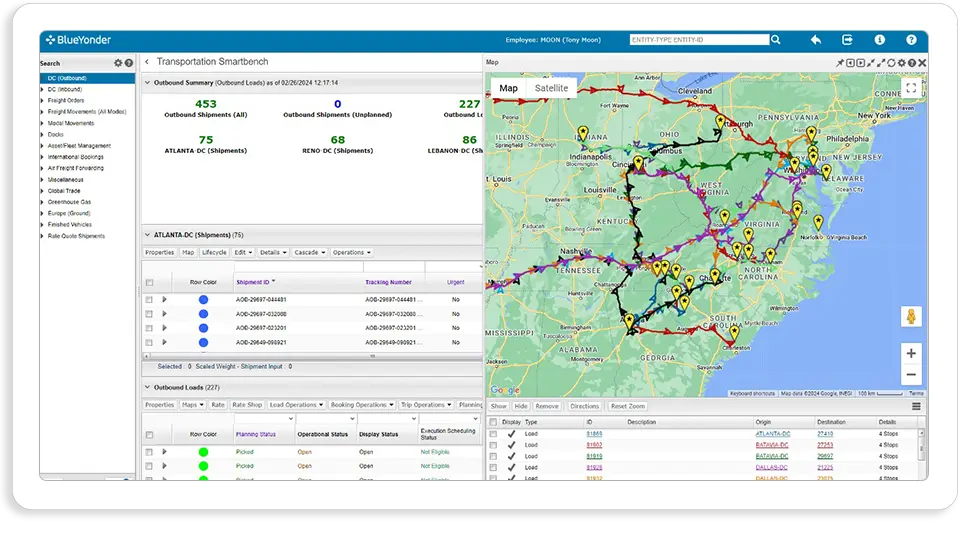
Blue Yonder offers a detailed overview of your transportation activities. Source: Blue Yonder
Blue Yonder’s TMS is best for businesses seeking cutting-edge technology to optimize costs and efficiency. It integrates deeply with its warehouse management and demand planning tools, making it ideal for complex logistics networks.
C.H. Robinson Navisphere – a 3PL-backed TMS with global reach
C.H. Robinson, one of the largest 3PLs in the world, offers Navisphere, a TMS that connects shippers to a vast network of carriers and logistics services. It is designed for businesses of all sizes and provides:
- direct access to one of the largest carrier networks;
- automated tendering and real-time capacity matching;
- AI-driven freight procurement and contract management;
- end-to-end shipment visibility with predictive tracking;
- integrated customs brokerage for international shipping; and
- self-service dashboards with dynamic analytics.
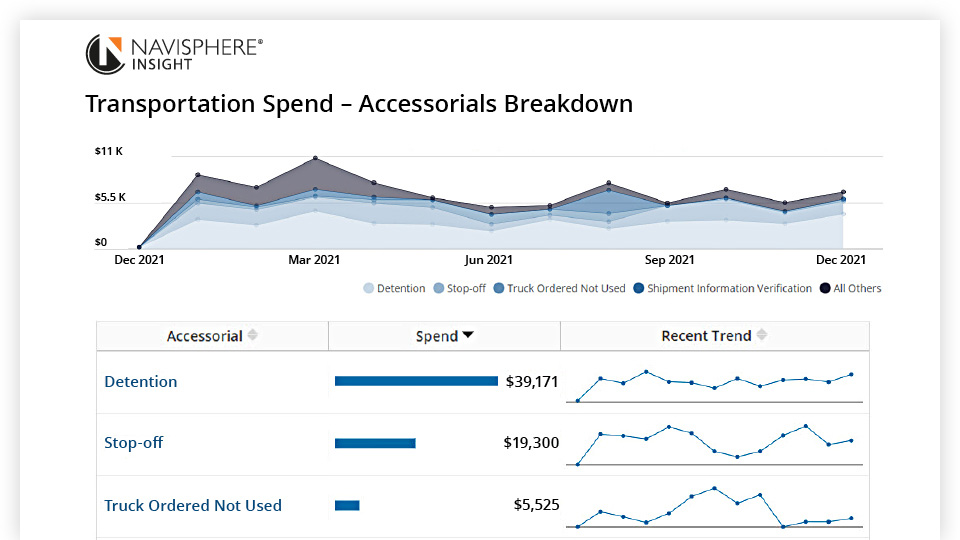
C.H. Robinson has detailed supply chain analytics as part of its Navisphere Insight product. Source: C.H. Robinson
Navisphere is best for companies looking to leverage C.H. Robinson’s extensive carrier relationships and logistics expertise. It’s particularly strong for businesses that need fast, flexible, and cost-effective freight solutions across multiple regions.
e2open Transportation Management – visibility and automation for global logistics
e2open’s cloud-based TMS is designed for shippers, logistics service providers, and freight forwarders who want end-to-end visibility and control over their supply chains. It integrates seamlessly with e2open’s broader supply chain network of over 490,000 enterprise, offering:
- real-time tracking with AI-powered predictive ETAs;
- dynamic carrier selection and automated tendering;
- multi-mode and multi-leg shipment management, including ocean, air, and land
- freight audit and settlement with automated invoicing and dispute resolution;
- scenario modeling for cost and service optimization; and
- collaboration tools for carriers, suppliers, and customers
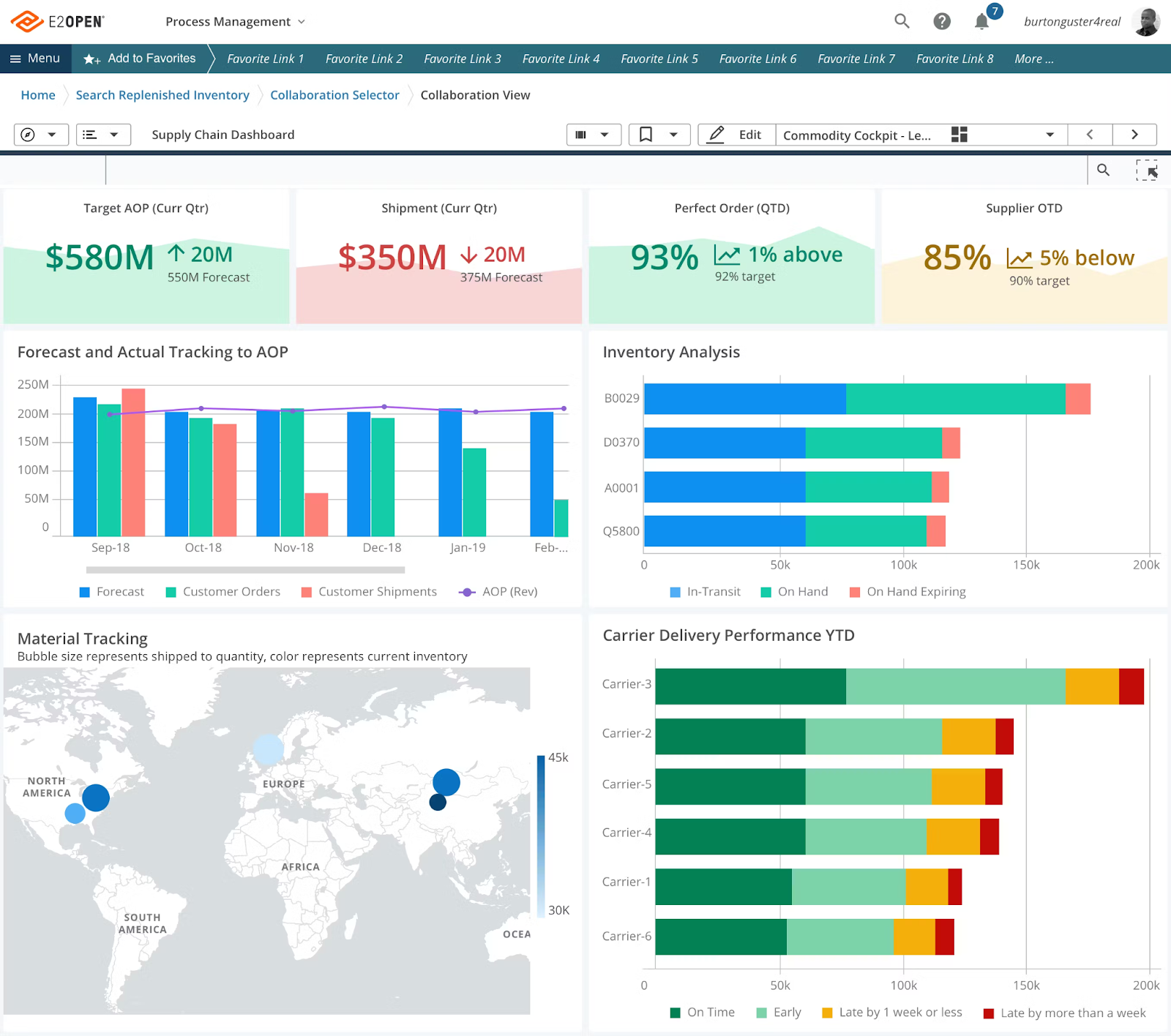
e2open’s supply chain software has a network of over 50,000 carriers. Source: Capterra
e2open excels in predictive analytics and visibility, making it a great choice for businesses that need real-time insights into their transportation operations. Their platform is modular, allowing you to expand functionality as needed.
Kuebix – scalable TMS with a free option for small shippers
Kuebix offers a cloud-based TMS designed for businesses of all sizes, from small shippers to large enterprises. With a free version for basic freight management and scalable paid options, it provides:
- multi-modal shipment management, covering LTL, FTL, and parcel;
- carrier rate comparison with instant quoting and booking;
- collaboration tools for shippers, carriers, and suppliers;
- freight intelligence dashboards for cost and performance analysis;
- integration with a ERP and WMS for seamless logistics automation; and
- fleet optimization with route planning and asset tracking
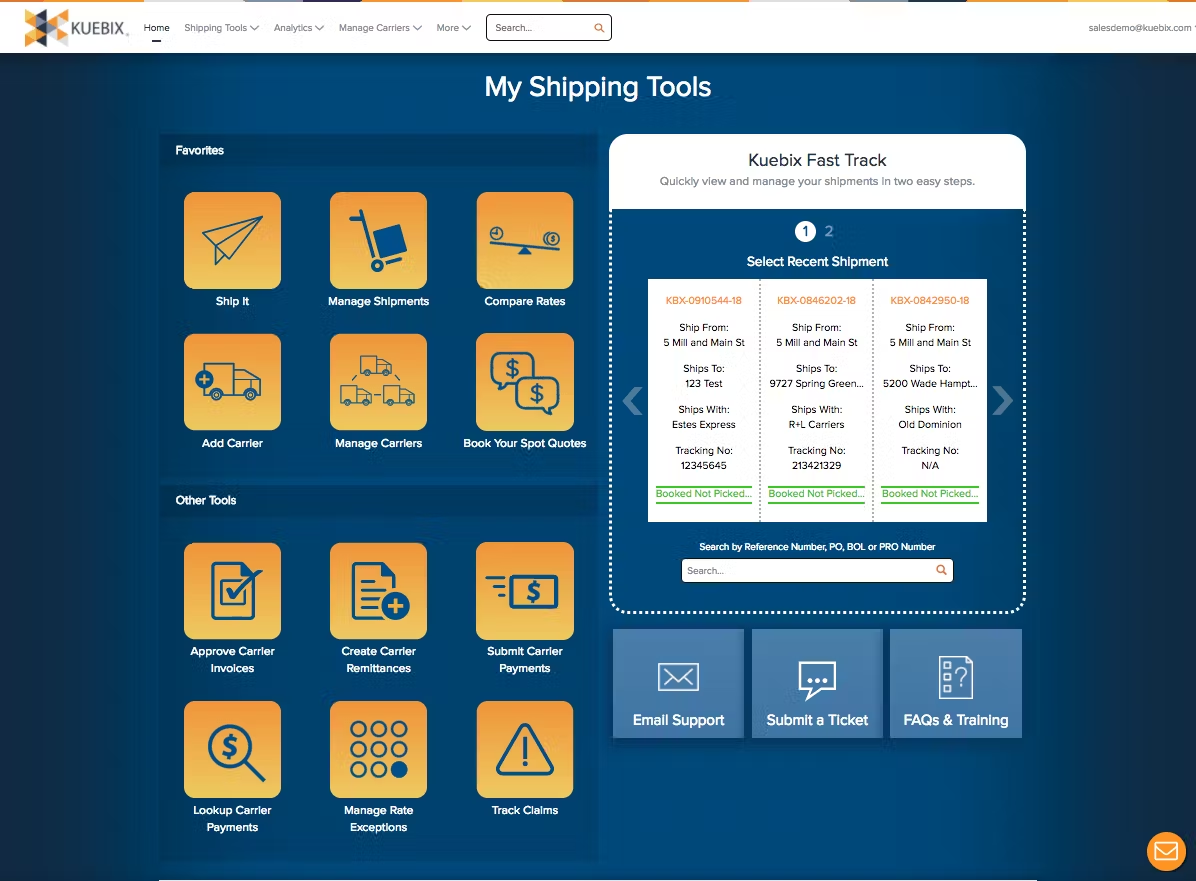
Kuebix has a range of integrations like Quickbooks, Infor and Oracle NetSuite. Source: Software Advice
Although Kuebix is not included in Gartner’s Magic Quadrant, we wanted to highlight its freemium model that makes it a great choice for small businesses looking for a cost-effective TMS, while enterprise features support complex supply chain operations.
Manhattan Associates TMS – unified supply chain execution for shippers and 3PLs
Manhattan Associates is known for its warehouse and transportation management solutions. Its TMS is called Manhattan Active and is built to support complex global supply chains with end-to-end orchestration. Key features include:
- AI-powered optimization for routing, consolidation, and fleet management;
- seamless integration with Manhattan WMS and order management systems;
- adaptive execution with real-time shipment tracking and disruption response;
- private fleet and common carrier management with cost analysis;
- automated freight audit and payment reconciliation; and
- load planning and dynamic allocation to reduce empty miles.

Control over the entire supply chain network with Manhattan Active. Source: Manhattan Associates via LinkedIn
Manhattan Associates’ TMS is ideal for businesses looking for a deeply integrated logistics solution that combines warehousing, fulfillment, and transportation into one seamless platform.
MercuryGate – flexible and modular TMS for dynamic logistics
MercuryGate delivers a scalable, highly configurable TMS that adapts to shippers, carriers, and 3PLs, offering fast deployment and intelligent automation. It provides:
- customizable transportation management with carrier compliance and contract handling;
- AI-powered optimization for load planning, carrier selection, and cost control;
- real-time visibility tools with control tower functionality;
- multi-modal execution, covering truckload, LTL, ocean, rail, and parcel;
- automated freight audit and settlement, integrated with financial systems; and
- business intelligence dashboards for custom analytics and reporting.
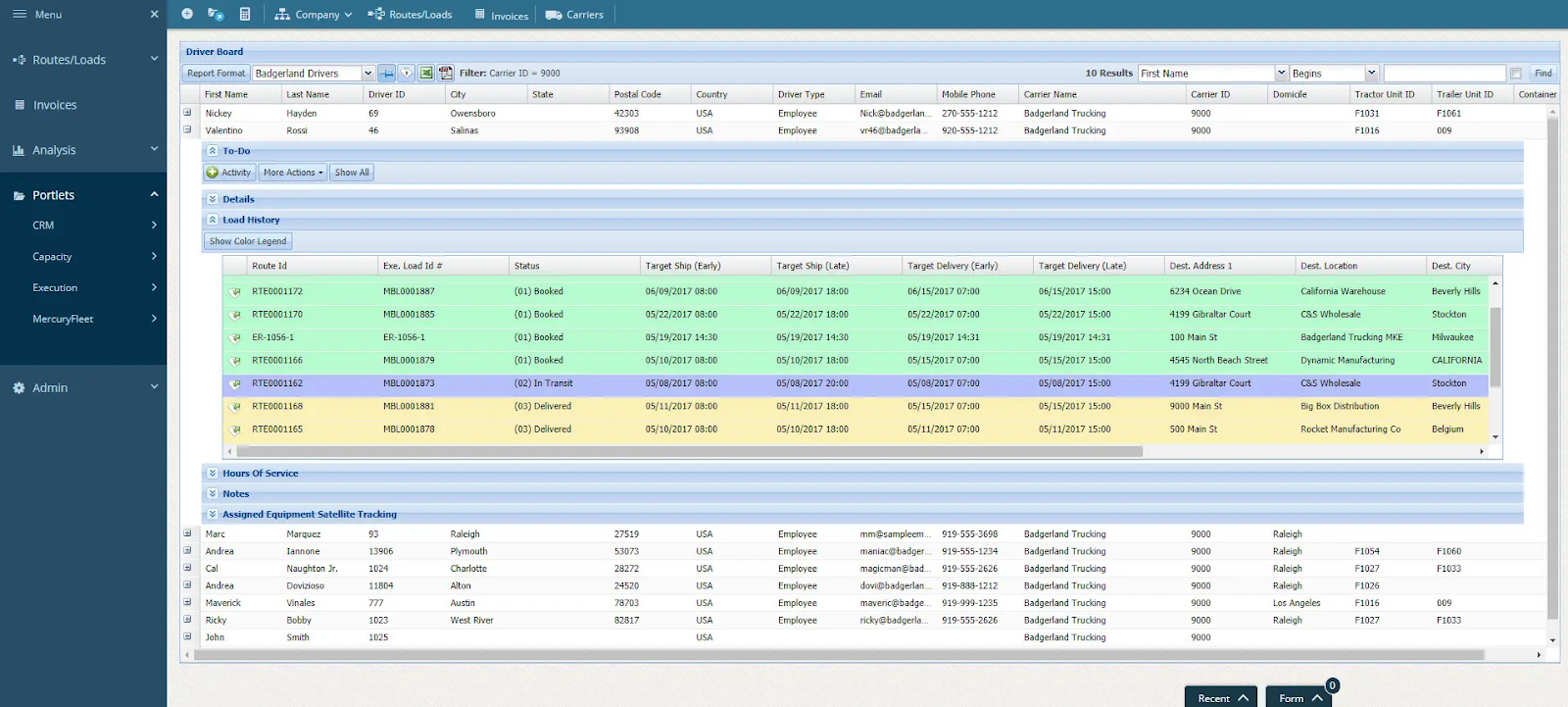
MercuryGate offers subscription-based pricing. Source: Software Advice
MercuryGate is ideal for businesses seeking a modular, quick-to-implement TMS that can scale and adapt to complex logistics needs.
Oracle Transportation Management (OTM) – complex and comprehensive solution
Oracle’s TMS is part of its broader supply chain management suite, offering deep automation, optimization, and financial control for shippers and logistics providers. It includes:
- AI-powered optimization for routing, carrier selection, and cost reduction;
- business process automation to streamline operations;
- global trade management for compliance and customs handling;
- integrated fleet management with real-time performance tracking;
- financial tools for freight auditing, automated payments, and billing; and
- scalable cloud ecosystem, integrating seamlessly with Oracle ERP and WMS.
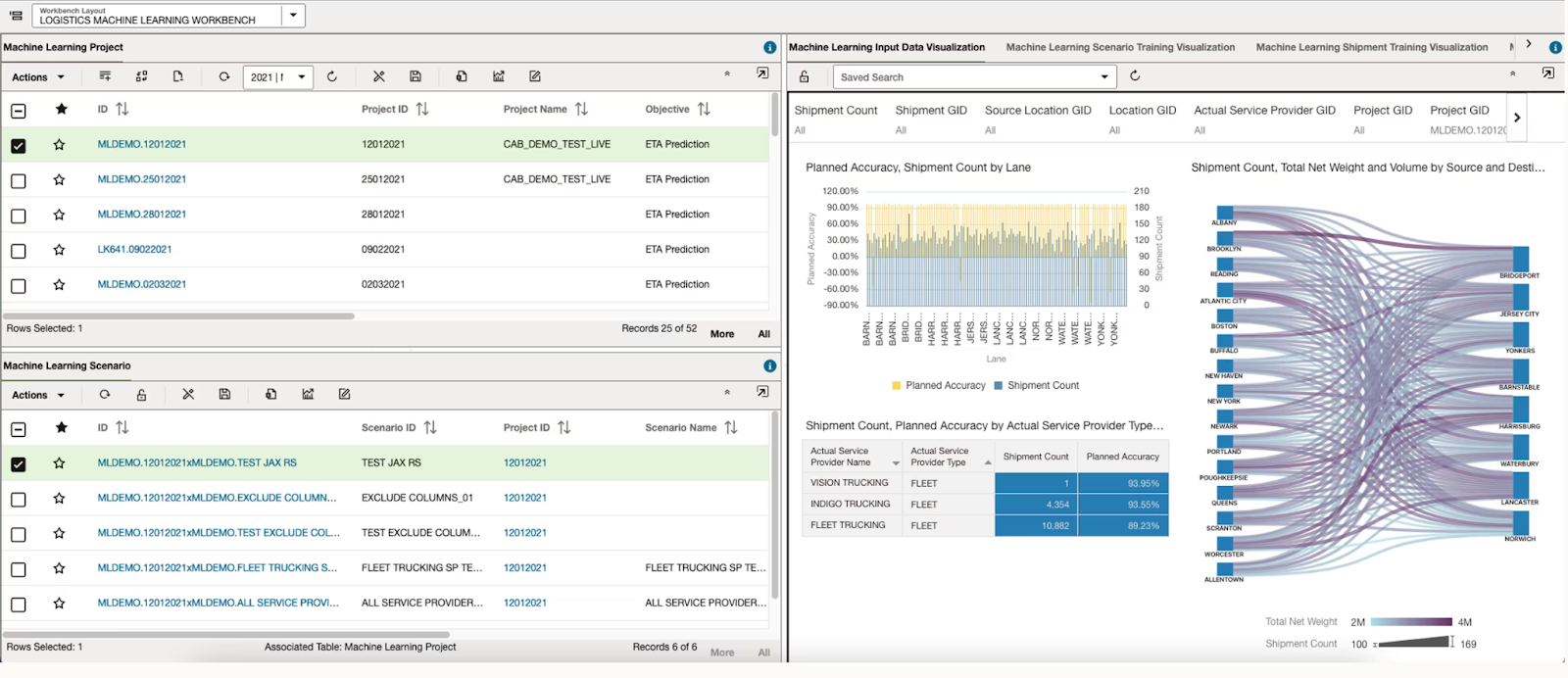
OTM allows predicting transit times to make better carrier and route decisions. Source: Oracle
OTM is ideal for large enterprises needing a powerful, end-to-end transportation solution with deep customization and global logistics support. If you’re up to the challenge, have the budget, and don’t want to be overwhelmed by choice, get the Oracle Transportation Management Cloud - an ecosystem of tools that will serve all your needs from complex routing to forwarding and brokering.
SAP Transportation Management (SAP TM) – seamless integration for SAP users
Oracle’s biggest competitor SAP also has an ecosystem of tools, including an ERP and a WMS, so it makes sense to use SAP if you have their other products. SAP TM is a powerful, AI-enhanced TMS built for seamless integration within the SAP supply chain ecosystem, providing intelligent logistics execution across industries. Key features include:
- end-to-end shipment planning with automated carrier selection;
- real-time freight tracking and cost management;
- integrated fleet and driver resource management;
- dynamic route optimization based on demand and constraints;
- automated freight documentation and compliance tracking; and
- advanced analytics and predictive insights powered by SAP HANA.
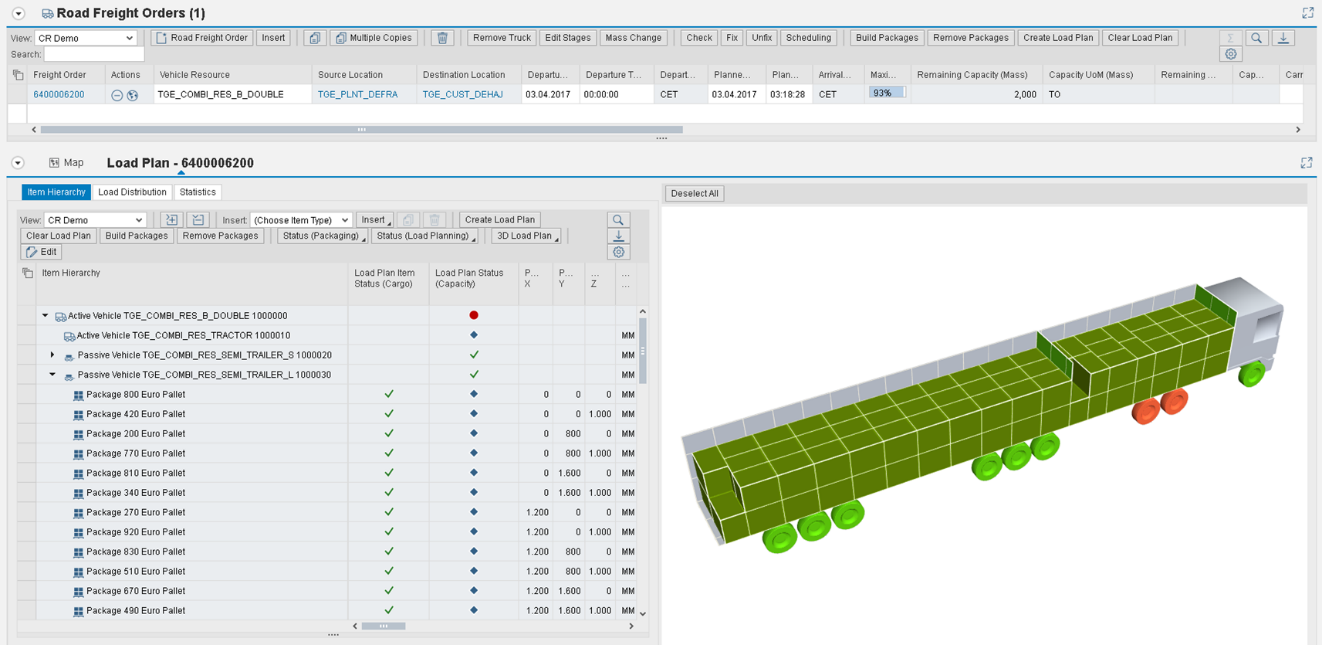
Planning with combination resources using SAP TM. Source: SAP
SAP TM is the go-to choice for enterprises using SAP ERP and WMS, ensuring full system connectivity and data consistency across their supply chain.
Uber Freight – Tech-driven logistics with on-demand capacity
Uber Freight brings the power of Uber’s technology to freight transportation, offering a fast, flexible, and digital-first approach to logistics. Designed for shippers of all sizes, Uber Freight provides:
- instant truckload pricing with real-time market rates;
- automated load booking for carriers via an easy-to-use mobile app;
- AI-driven route optimization to reduce costs and transit times;
- real-time tracking and predictive ETAs;
- self-service dashboards with shipment insights and analytics; and
- integrated payment processing, ensuring fast payouts for carriers.
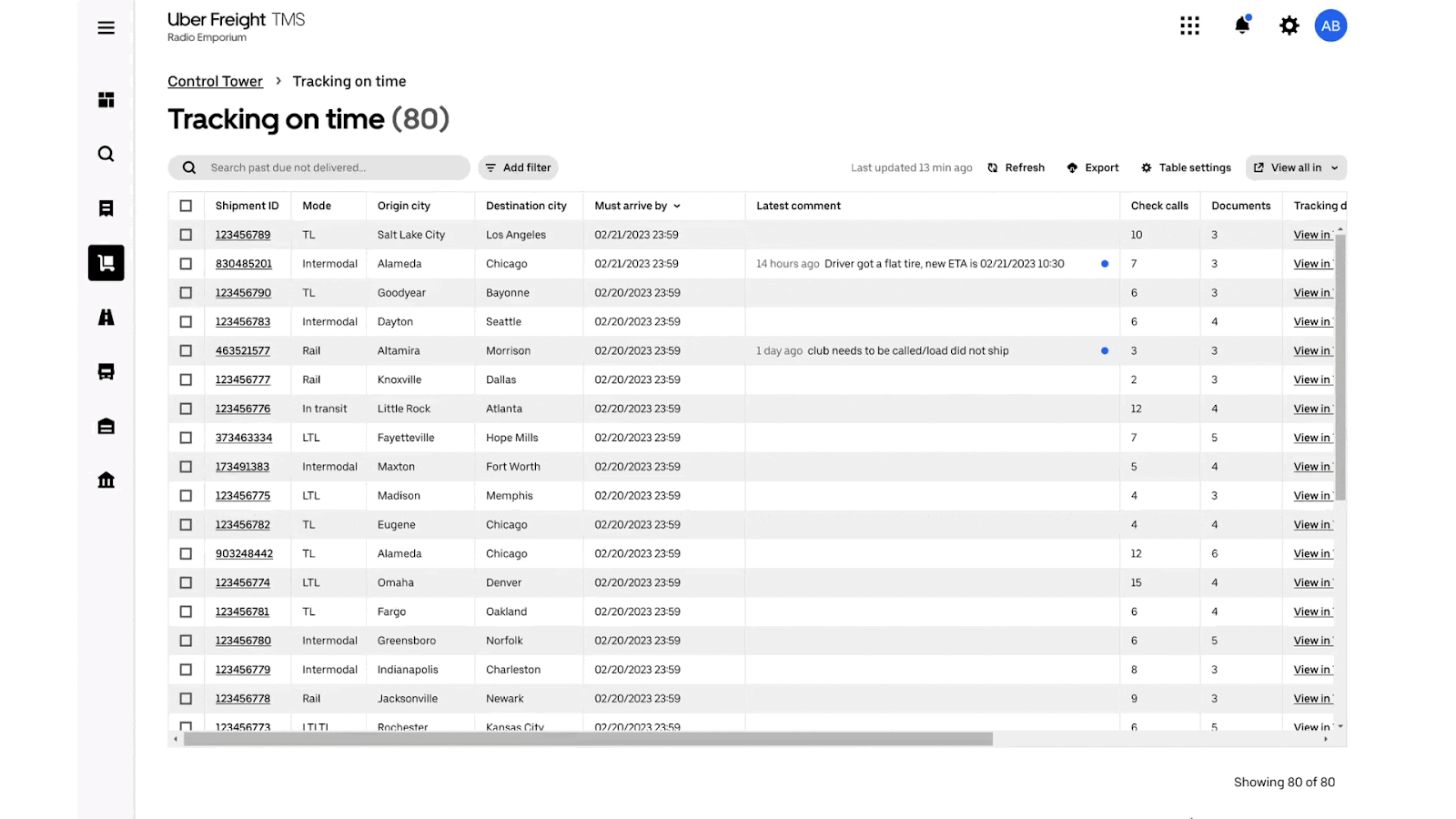
An overview of Uber Freight TMS. Source: Uber Freight
Uber Freight is an ideal TMS for businesses that need flexibility and on-demand freight solutions without the complexity of traditional transportation management systems. It’s particularly strong for domestic U.S. freight and spot freight booking.
Transportation management software development
The nature of the transportation industry and the pace at which it’s digitizing makes it impossible to purchase and run a TMS solution out of the box - it will most likely require customization. Most vendors provide APIs and web service architecture so you can apply some engineering efforts to connect them to your existing systems. Yet, this process becomes increasingly complex if you pick several tools from different vendors, need to move from a legacy system, and write some custom code.
Another option is developing a custom TMS from the ground up. If you don’t have a reliable ERP or warehouse system to connect a TMS to, it makes sense to build exactly what you need instead of trying to combine different products on the market.
What does the future hold?
Freight volume keeps growing every year, increasing the complexity and pressure on the transportation market. While the industry is evolving to satisfy demand, adapt to customer requirements, and comply with regulations and sustainability goals, brands’ needs change as well. They strive for more automation, transparency, analytics, and first and foremost – digitization.
Shippers and carriers alike must abandon paper-based processes not only to compete but to survive. And it’s not that hard when the technology is here, offering efficient machine-to-machine communication, accurate routing algorithms, immediate mobile access, and a lot of other handy perks. As incredible as it may seem, there’s still a lot of innovations available today that you can enhance your TMS with.
Predictive analytics powered by machine learning can support your strategic decision-making by generating accurate predictions and comparing different scenarios. You can apply it to evaluating carriers, defining high-risk loads, optimizing routes, planning capacity and operations, and much more.
IoT devices hold a lot of potential to enhance numerous supply chain processes and provide unprecedented visibility. Smart sensors can play a tremendous role in shipment tracking, fleet maintenance, storage monitoring, and so on.
Blockchain technology, in spite of its novelty and related challenges, is being implemented to improve traceability and security of logistics operations. Read more about how blockchain is used in the supply chain in our dedicated post.
Technologies are evolving together with the transportation industry. So now, knowing the opportunities software provides, you can implement the right solutions to automate your business operations, offer better service to your customers, and gain competitive advantage.

Maryna is a passionate writer with a talent for simplifying complex topics for readers of all backgrounds. With 7 years of experience writing about travel technology, she is well-versed in the field. Outside of her professional writing, she enjoys reading, video games, and fashion.
Want to write an article for our blog? Read our requirements and guidelines to become a contributor.

